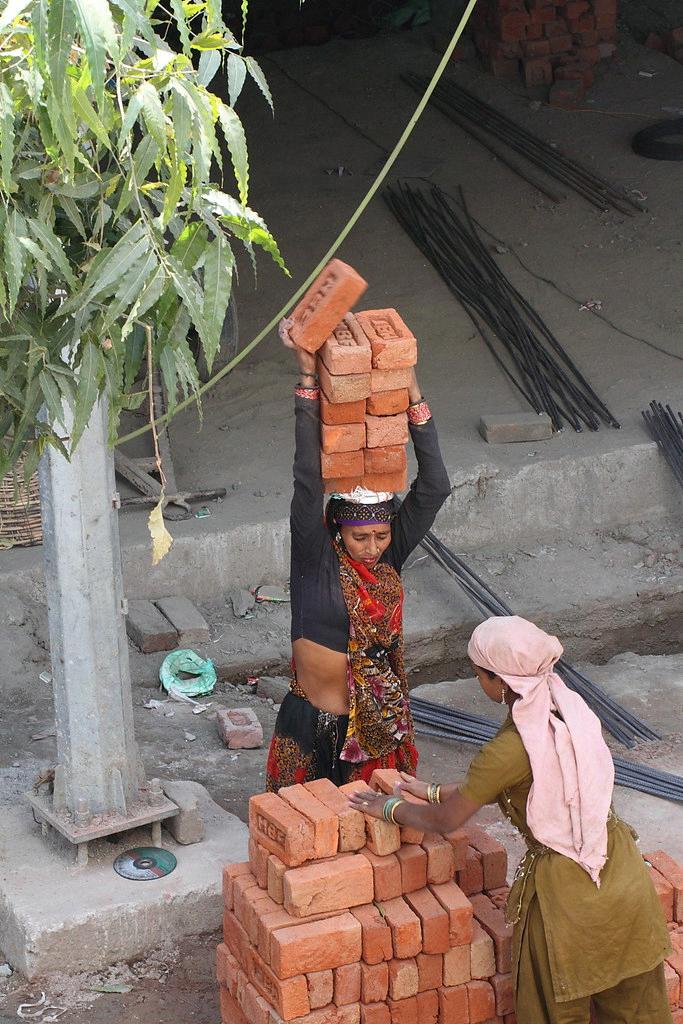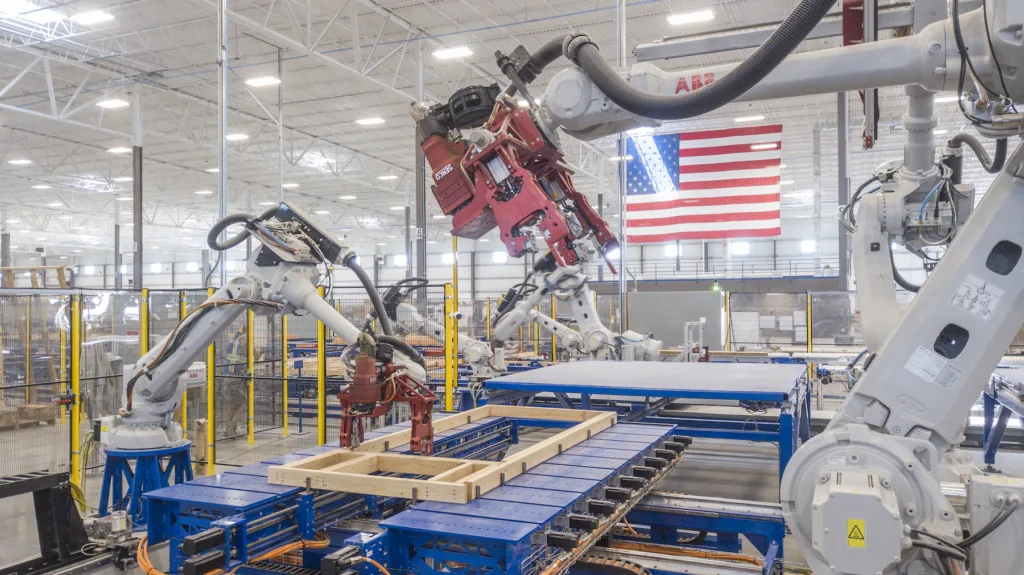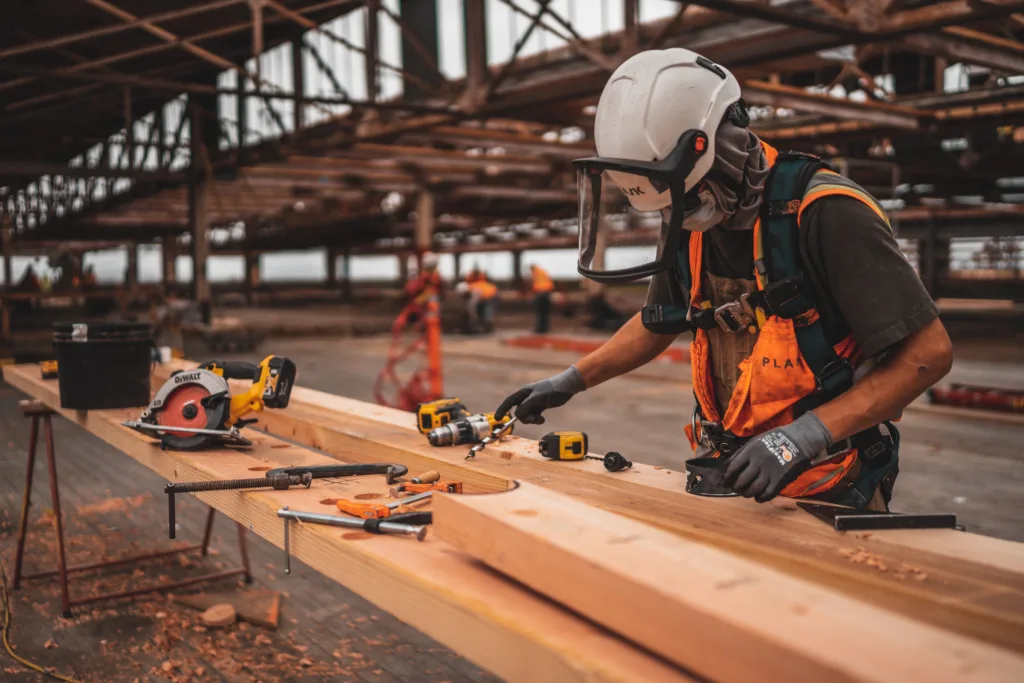If you’ve ever walked by a construction site, you may have seen workers carrying a large bucket-like tool filled with bricks or other supplies – that’s a hod. And the workers carrying those hods are known as hod carriers, or “hoddies” for short.
Hod carrying is a physically demanding job that requires strength, endurance, and precision. Hod carriers are responsible for transporting materials like bricks, stones, cement, and plaster to construction sites and delivering them to the bricklayers, stonemasons, or cement finishers working on the job.
A typical day for a hod carrier can be grueling – they may carry anywhere from 1,000 to 2,000 bricks a day! This requires a lot of physical exertion, and hod carriers must be in good physical shape to keep up with the demands of the job. They often work alongside two bricklayers at a time and must coordinate with them to ensure that the right materials are delivered to the right location at the right time.
In addition to physical strength, hod carrying also requires a high level of organization and attention to detail. Hod carriers must be able to keep track of the materials they are carrying, ensure that they are delivered to the correct location, and maintain a safe and clean work environment. They must also be able to work efficiently and quickly, as delays in material delivery can slow down the entire construction process.
Hod carrying is a vital part of the construction industry and plays an important role in ensuring that buildings are constructed safely and efficiently. Without hod carriers, bricklayers and other construction workers would not have the supplies they need to complete teir work.
Hod carrying is a challenging and physically demanding job that requires strength, endurance, organization, and attention to detail. Hod carriers play a vital role in the construction industry and are essential to the success of any construction project.
The Meaning of Carrying a Hod
Carrying a hod refers to a manual labor job in the construction industry. A hod is a tool used to transport and hold building materials such as bricks, stones, cement, or plaster. The hod is typically made of wood, metal, or plastic and features a handle on one end and a container on the other. The container is usualy rectangular or square in shape and has a flat bottom, allowing it to rest on the ground.
A person who carries a hod is known as a hod carrier. The hod carrier’s primary role is to transport building materials from one location to another on the construction site. The materials are usually carried up and down ladders or scaffoldings to reach the area where they are needed. The hod carrier works closely with bricklayers, stonemasons, cement finishers or plasterers, providing them with the necessary materials to complete their work.
The job of a hod carrier requires a great deal of physical strength and stamina. The worker must be able to lift and carry heavy loads of materials over long distances and up and down stairs or ladders. The worker must also have good hand-eye coordination and be able to balance the materials on the hod while in motion.
Carrying a hod is a manual labor job in the construction industry that involves transporting building materials from one location to another on the job site. The hod carrier is responsible for providing bricklayers, stonemasons, cement finishers, and plasterers with the necessary materials to complete their work. The job requires physical strength, stamina, and good hand-eye coordination.

Source: youtube.com
The Benefits of Hard Work: Examining Hod’s Approach
Hod carrying is widely recognized as one of the most physically demanding and challenging jobs in the construction industry. This job involves carrying a hod, a tool used in masonry, which typically consists of a metal or wooden trough with a handle, used for transporting and placing bricks, concrete, and other building materials.
The work of carrying hods is physically demanding and requires a great deal of strength and endurance, as hods can weigh up to 80 pounds when fully loaded with bricks or concrete. Hod carriers must also be able to work in all types of weather conditions, including extreme heat or cold, which can make the job even more difficult.
In addition to the physical challenges, hod carrying also requires a high degree of precision and attention to detail. Hod carriers must be able to accurately place and position building materials to ensure that they are level and secure. They must also be able to work quickly and efficiently, as they are often responsible for keeping up with the pace of the other workers on the job site.
Organization and coordination are also key skills for hod carriers, as they must be able to keep track of the materials they are transporting and ensure that they are delivered to the correct location at the riht time. This requires excellent communication and teamwork skills, as hod carriers must work closely with other construction workers to ensure that materials are delivered and placed correctly.
Hod carrying is undoubtedly a challenging and demanding job that requires a great deal of physical strength, endurance, precision, and organization. However, for those who are up to the task, it can also be a rewarding and fulfilling career in the construction industry.
What Is the Title of a Hod Carrier?
A hod carrier, also known as a “Hoddie,” is a tradesman who is typically employed in the construction industry. The primary responsibility of a hod carrier is to transport bricks, mortar, and other construction materials from one location to another. They work in close collaboration with bricklayers, and their primary role is to ensure that the bricklayers have the necessary materials to complete their tasks.
The term “hod” refers to the tool that hod carriers use to transport materials. A hod is a large, rectangular container made of wood, metal, or plastic, with a handle at the top that is used to carry bricks and other building materials. Hod carriers are responsible for loading the hods with materials, carrying them to the job site, and unloading them for the bricklayers to use.
Hod carriers are an essential part of the construction industry, and their work is physically demanding. They are required to carry heavy loads of materials over long distances, ofen up and down stairs and through narrow passageways. The job requires a high level of physical fitness, as well as the ability to work in a team environment.
A hod carrier is a tradesman who works in the construction industry, whose primary responsibility is to transport bricks and other building materials using a tool called a hod. They work in close collaboration with bricklayers and are an essential part of the construction process.
The Role of a HOD Carrier in Relation to Labourers
A hod carrier is a type of labourer who works in the building industry. Their main role is to support bricklayers by carrying bricks, mortar, and other materials to the construction site. Hod carriers are responsible for mixing mortar and preparing it for use by the bricklayers. They also clean up the work area and ensure that the construction site is safe for workers and visitors.
Hod carriers play an important role in the construction industry as they help to ensure that bricklaying projects are completed on time and to a high standard. They work closely with bricklayers and other construction workers to ensure that materials are available when needed and that the work area is kept clean and safe.
In addition to carrying materials and mixing mortar, hod carriers may also be responsible for other tasks related to construction, such as digging trenches or laying concrete. They may also be required to operate machinery or tools, depending on the specific job requirements.
Hod carriers are an important part of the construction industry and play a critical role in ensuring that bricklaying projects are completed successfully.
Average Salary of a Hod Carrier
Hod carriers are an essential part of the construction industry, responsible for moving and distributing materials around building sites. Their work is physically demanding and requires a significant amount of manual labor. Hod carrier salaries can vary depending on a range of factors, including experience, location, and employer.
On average, hod carriers in the UK earn between £28,000 to £38,000 annually. This figure is based on data from industry sources and represents a typical salary range for the position. However, it’s important to note that this figure can vary depending on severl factors, including the region of the UK where the work is taking place and the specific employer.
In addition to their base salary, hod carriers may also be entitled to a range of benefits. These can include a company van, a fuel card, pension contributions, and generous holiday entitlements. Overtime is often available, providing the opportunity to earn additional income.
Working hours for hod carriers are typically standard, with a typical Monday to Friday schedule. However, there may be some variation depending on the specific employer and location.
For those looking to progress in their careers, there are often opportunities to move up the ranks within the construction industry. This can involve taking on additional responsibilities or training in new skills. the role of a hod carrier can be physically demanding, but it can also be a rewarding career path with opportunities for growth and development.
Hod carriers in the UK can expect to earn a salary ranging between £28,000 to £38,000 annually, with additional benefits such as a company van, fuel card, pension contributions, and generous holiday entitlements. The role involves physically demanding work and standard working hours, with opportunities for career progression within the construction industry.

Source: flickr.com
Do Builders Still Utilize Hods?
Hods have been a commonly used tool in the construction industry for centuries. Traditionally, builders would use hods to carry materials such as bricks, mortar, and plaster up and down stairs or across rough terrain. However, with advances in technology and safety regulations, the use of hods in construction has decreased in recent years.
Nowadays, builders tend to use more modern tools such as wheelbarrows and cranes to move materials around construction sites. This is because hods can be heavy and difficult to maneuver, which can lead to accidents and injuries. In addition, using hods can be time-consuming, as it requires the builder to manually carry each load of materials.
Furthermore, health and safety regulations have become increasingly strict in recent years, and the use of hods is no longer considered safe or acceptable on many construction sites. For example, carrying heavy loads up and down stairs can put a strain on the builder’s back and joints, which can lead to long-term health problems.
While hods have been a staple tool in the construction industry for many years, their use has decreased in recent years due to advances in technology and safety regulations. Builders now tend to use more modern tools such as wheelbarrows and cranes to move materials around construction sites, as these tools are safer, more efficient, and less liely to cause accidents or injuries.
Understanding the HOD Qualification
HOD qualification refers to the educational qualifications required for the position of Head of Department in an academic institution. As per the official notification, the minimum qualification required for this position is a Master’s degree in the relevant field from a Central / State / Deemed to be University recognized by UGC, or an equivalent degree / diploma from a foreign university / institution recognized by AIU.
Additionally, having a PhD degree is considered desirable for the position of HOD. This indictes that the candidate has a higher level of expertise and knowledge in their field of study. Furthermore, having research paper publications in reputed journals is also considered as a desirable qualification. This indicates that the candidate has made significant contributions to the field of study and has the ability to conduct and publish research.
It is important to note that the qualifications for the position of HOD may vary depending on the institution and the field of study. However, the minimum requirement is generally a Master’s degree from a recognized university.
What Is The Role of a Bricklayer Assistant?
A bricklayer assistant is commonly referred to by several different job titles, including bricklayer helper, hod carrier, marble finisher helper, and mason tender. These individuals work alongside professional bricklayers, blockmasons, stonemasons, and tile and marble setters to help with various aspects of the job.
Bricklayer helpers typically assist with mixing and transporting materials, such as mortar and bricks, to the job site. They may also help with laying bricks, preparing surfaces for installation, and cleaning up debris. Hod carriers specifically focus on carrying and stacking bricks, while marble finisher helpers assist with the installation and finishing of marble surfaces.
Mason tenders, on the other hand, have a broader job description and may assist with all aspects of masonry work. This can include mixing and transporting materials, setting up scaffolding, handling tools, and assisting with the installation and finishing of various types of masonry surfaces.
Bricklayer assistants play an important role in the masonry industry and provde invaluable support for professional masons.
Understanding the Role of a HOD in Construction
In the construction industry, a hod is a tool used to transport materials such as bricks, stones, and mortar from one place to another on a construction site. It is a rectangular-shaped box with high sides and a long handle attached to it, which is used for carrying it on the shoulder or by hand. The hod is typically made of metal or wood.
A hod is an essential tool for construction workers, especially for bricklayers and masons. They use the hod to transport the materials they need to build walls, chimneys, and other structures. The hod carrier usully works closely with the bricklayer or mason, ensuring that they have a steady supply of materials to work with.
The hod carrier’s job is physically demanding, and they need to be in good physical condition to handle the weight of the materials they carry. Depending on the type of construction project, a hod carrier may also be responsible for mixing mortar and preparing the materials for use.
Some of the key responsibilities of a hod carrier include:
– Carrying materials such as bricks, stones, and mortar from one place to another on a construction site
– Ensuring that the bricklayer or mason has a steady supply of materials to work with
– Mixing mortar and preparing materials for use
– Maintaining a clean and safe work area
A hod is a tool used in construction to transport materials, and a hod carrier is responsible for using it to ensure that bricklayers and masons have a steady supply of materials to work with.

The Role of a Hod Carrier
A hod carrier is a skilled laborer who works alongside bricklayers to supply them with bricks and cement. The term hod carrier originates from the tool they use to carry the materials, called a hod. The hod is a three-sided container made of metal or wood that hod carriers use to hoist and transport a number of bricks or cement. The primary responsibility of a hod carrier is to ensure that bricklayers have a constant supply of materials to complete their work efficiently. A hod carrier typically carries around 10 to 12 bricks at a time in the hod. In addition to carrying bricks, they also carry cement, sand, and other materials neessary for the bricklaying process. Typically, one hod carrier will supply two bricklayers, but this may vary depending on the size of the job. Hod carriers must have excellent physical stamina and be able to work quickly and efficiently to keep up with the bricklayers’ pace. They also need to have good communication skills to coordinate with the bricklayers and ensure that they have the materials they need at all times.
Do Labourers Need a Degree?
In short, the answer is no, you do not need a degree to become a labourer. However, thre are certain skills and qualifications that can increase your chances of being hired for labourer positions.
Labourers are typically responsible for performing manual work on construction sites, such as digging trenches, carrying materials, and using tools to assist other workers. While a degree is not required for this type of work, having experience in construction or other related fields can be beneficial.
Some employers may prefer candidates with a certification in a specific trade or skill, such as welding or scaffolding. These certifications can be obtained through vocational schools or community colleges, and demonstrate to employers that you have a certain level of expertise in a particular area.
Additionally, some labourer positions may require certain physical abilities, such as being able to lift heavy objects or work in outdoor environments. It’s important to assess your own physical abilities and ensure that you are able to meet the demands of the job before applying.
While a degree is not necessary to become a labourer, having relevant experience, certifications, and physical abilities can increase your chances of being hired for these types of positions.

What Is the Job Title of a Labourer?
A labourer is a person who performs manual work that requires physical effort, often in industries such as construction, manufacturing, agriculture, or mining. They are also commonly referred to as workers, workmen or women, working persons, or manual workers. The job of a labourer often involves tasks such as lifting heavy loads, operating machinery, digging, and carrying out othr physically demanding work.
Labourers may work in a variety of settings, including factories, warehouses, construction sites, farms, and mines. They typically work under the direction of a supervisor or manager and may work in teams or independently.
Some common synonyms for labourer include worker, operative, employee, staff member, and operative. While these terms may have slightly different connotations, they are often used interchangeably to refer to individuals who perform manual work.
A labourer is a person who engages in manual work that requires physical effort, often in industries such as construction, manufacturing, agriculture, or mining. They may be referred to by a variety of names, including worker, workman or woman, working person, or manual worker.
Can Anyone Become a Labourer?
The role of labourer is a physically demanding job that requires a certain level of fitness and the ability to handle manual labour. It is a job that involves working on construction sites, performing tasks such as digging, carrying heavy loads, and operating machinery.
While there are no specific academic requirements to become a labourer, there are certain skills and qualities that are necessary to excel in this role. These include physical strength, stamina, and dexterity, as well as the ability to work well in a team and follow instructions.
In addition, to work as a labourer in the UK, you will need to obtain a CSCS green card, which requires completing a Health, Safety and Environment Test, as well as an appropriate training course. This card is essential to prove your competence and suitability for the job.
It is worth noting, however, that labouring is a highly competitive industry, and employers may require additional qualifications or experience, especially for more specialized roles. Therefore, whie anyone can technically become a labourer, it is important to be aware of the requirements of the job and the expectations of employers.
While anyone can potentially work as a labourer, this role requires certain physical and personal qualities, as well as the appropriate qualifications and training.
Conclusion
Hod carrying is an essential job in the construction industry, providing support to bricklayers, stonemasons, cement finishers, or plasterers on the job. It is a physically demanding job that requires strength, endurance, and precision. Hod carriers carry heavy loads of materials, including bricks, blocks, and mortar, from one place to another on the construction site.
Hod carriers work closely with bricklayers, ensuring they have the materials they need to complete ther work. They are responsible for organizing and managing the materials, ensuring they are delivered to the right place at the right time. Hod carriers must be able to work efficiently and effectively, often under challenging conditions, to ensure the success of the project.
Despite the challenges, hod carrying is a rewarding job for those who are up to the task. It provides an opportunity to work in the construction industry, learning from experienced professionals and gaining valuable skills. Hod carriers are an essential part of any construction team, and their hard work and dedication are critical to the success of the project.
Hod carrying is a demanding but essential job in the construction industry. It requires strength, endurance, and precision, and is critical to the success of any building project. Hod carriers are an integral part of any construction team, and their hard work and dedication play a vital role in ensuring the project’s success.
